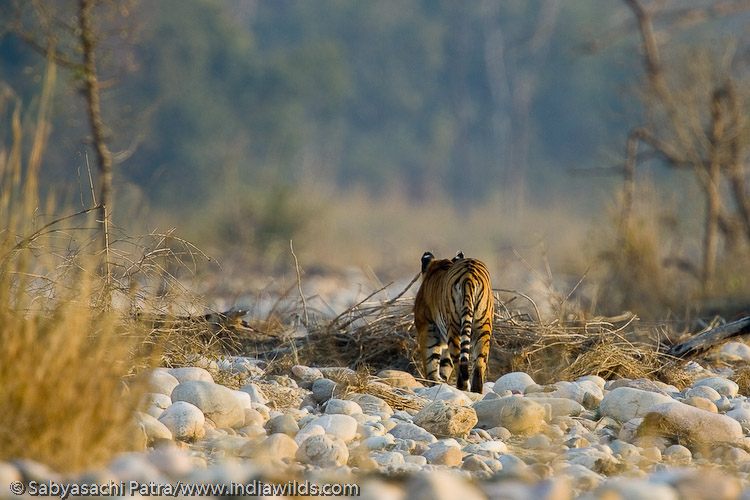IndiaWilds Newsletter Vol. 8 Issue IV
Celebrating Tigers in Dire Straits
51 tiger deaths in 2016 in the first quarter. According to conventional logic used by the Customs authorities, only 10% gets seized. If we use that logic in tiger deaths, since the poaching and seizure statistics compiled by WPSI reveals 26 tiger poached, the actual can even be 260. This should cause immense concern among conservationists. Alas! That’s not the case.
Infact, instead of worrying and raising our voice to pull out the tiger from the brink, people are celebrating. WWF, a leading NGO wants us to believe that all is well with the tiger and has issued a release talking about global tiger numbers going up to 3890. It says “This updated minimum figure, compiled from IUCN data and the latest national tiger surveys, indicates an increase on the 2010 estimate of ‘as few as 3,200’, and can be attributed to multiple factors including increases in tiger populations in India, Russia, Nepal and Bhutan, improved surveys and enhanced protection.”
WWF attributes tiger numbers to have increased due to “improved surveys”. However, the improved surveys, atleast in India – the country which is home to the largest number of wild tigers – is not scientifically robust.
http://www.indiawilds.com/diary/indiawilds-newsletter-vol-7-issue-i/

India is supposed to have 57.223% of tiger numbers. Why 57.223% and not simply report it as 57%? Well this is just a theatre of the absurd. So it doesn’t matter how many digits after the decimal point we are mentioning. Let me explain.
According to WWF the global tiger population is 3890 and it terms it as a “minimum figure”. Unfortunately it is farther from the truth.
In the press release WWF quotes 3890 as the number of wild tigers in the world. Unlike the Government of India human population census where the total number of people are counted by visiting door to door, tiger census is an exercise in estimating the tiger numbers. There is no physical counting. The 2014 estimates of tiger population in India was between 1945 to 2491 and the mean is 2226. The 3890 number quoted by WWF is not the minimum number of tigers in the wild. If WWF would have wanted to project minimum number of tigers than it should have taken the lowest number from the range 1945-2491 and not the mean of 2226.
Picking up the mean and adding up with other such estimates around the world, finding out percentages is just a ridiculous exercise, especially since data itself is suspect. WWF chooses to ignore this fact by terming it as “best available data”.
In the last tiger census in India, the tiger numbers jumped to a stunning 30%. (Status of Tigers in India: 2014 – http://projecttiger.nic.in/WriteReadData/LetestNews/Document/Tiger%20Status%20booklet_XPS170115212.pdf )
In this tiger census the double sampling methodology was utilised which uses data acquired from ground based surveys as well as camera traps. According to Dr Ullas Karanth,
“The double sampling method is not the best currently available methodology for this task. We do not believe this method can yield sufficiently refined results to accurately measure changes in tiger numbers at landscape or country-wide scales as is being attempted.”

A angry male wild tiger partly hidden in grass snarls at the tourists blocking its path. It is the dominant male of the Rajbehera area in Bandhavgarh National Park, India
In 2006 census the tiger numbers were estimated between 1165 to 1657 with a mean of 1411. In 2010 census, the tiger numbers were estimated to be 1520 at the lowest to1909 at the highest with a mean of 1706. In the 2010 tiger estimation exercise, despite throwing up higher numbers the range of tiger areas were shown to have decreased. “This decline in tiger occupancy was recorded in areas outside of tiger reserves, indicating loss of habitat quality and extent – a crucial element essential for maintaining genetic connectivity between individual tiger populations”.
In 2014 report the number of tigers were estimated to be within a range of 1945 at the lowest to 2491 at the highest with the mean at 2226. Unfortunately, the WWF exercise as well as people take the mean as the absolute tiger number.

The Tiger census report didn’t mention the data on the amount of areas devoid of tigers since the last census. After the 2010 census, the UPA led Government at the centre in India was well on its way to fight a negative perception arising out of scams and started opening up rich forest areas to mining and other deleterious projects. The minister for MoEF who was seen as a thorn in the Development vs Conservation battle was moved away from this ministry by promoting him to Cabinet rank. After the 2014 Parliamentary elections, the new NDA Government has shown an immense proclivity to strike at the core tiger landscapes fragmenting and decimating them for industrial growth, road and other infrastructure projects. So it is indeed a mystery that the India tiger numbers jumped by 30% in the 2014 census.
The 2014 assessment report says “tiger populations, indicative of intact functioning ecosystems, respond well to reduction in human pressures, protection, prey availability and good quality habitats. The political will, conservation commitment by wildlife managers and improved protection have paid dividends”.
Unfortunately, tigers are poached even from our premier tiger reserves. One doesn’t even know what is happening in the smaller sanctuaries. Our National Parks, Sanctuaries and other Protected Areas have lot of vacancies in terms of field staff. In some of the premier places the emphasis is more on tourism than on field patrolling. In most of the buffer areas in number of states the Government has allowed declaring the prey species of tigers like Nilgai, wild boar etc as vermin and allow their hunting. This reduces the prey availability, especially in the buffer areas and the areas outside our protected areas. So when tigers try to move out from the source landscapes to populate other wilderness areas, they can’t hunt on their prey. So a wandering tiger is more likely to depend on killing livestock than its normal prey in those areas.
The traditional prey species of tigers are also out-competed by the domestic livestock. Even our sanctuaries and National Parks are not immune to the problem of grazing inside their boundaries.

Predator and Prey
The political will mostly remains limited to press releases and sound bites on different occasions and doesn’t come forward to protect the fragmentation of habitat. Just declaring the existing sanctuaries as tiger reserves doesn’t give us much benefit as funds continue to remain a problem for the tiger reserves.
According to the Status of Tigers in India, 2014 report “Areas where there is a potential for increasing tiger populations are Sanjay-Guru Ghasidas landscape shared by Madhya Pradesh and Chattisgarh, Kawal and Srisailam Tiger Reserve in Andhra Pradesh and Telangana, Simlipal and Satkosia Tiger Reserves in Odisha, Manas Tiger Reserve in Assam, Buxa Tiger Reserve in West Bengal, Palamau Tiger Reserve in Jharkhand, Achanakmar and Indravati Tiger reserves in Chhattisgarh. These Protected Areas would benefit from conservation inputs that restore habitat, prey populations and in extreme cases supplementation of tigers so as to ensure that these PAs continue to deliver ecosystem services at their optimal levels. Future of tigers in India depends on maintaining inviolate core habitats for breeding tiger populations, habitat connectivity for genetic exchange and protection from poaching of tigers and their prey”.
The amount of poaching in these tiger reserves is very high. Some of these places like Satkosia tiger reserve is now completely devoid of tigers. Infact, when a tiger in 2013 wandered into Nandankanan zoo in Bhubaneshwar, there was a proposal to shift it to Satkosia. But the Satkosia Tiger Reserve authorities refused because they believed they won’t be able to accord protection to the tiger. The anthropogenic activities like livestock grazing, wood cutting as well as poaching is pretty high in these areas. Sighting a prey species like a Sambar is becoming extremely tough in places like Similipal and Satkosia.
Though the official tiger census report talks about Habitat connectivity for genetic exchange the Government doesn’t seem to believe it to be important. Else, the Government would have taken precautions in creating the necessary mitigation plans in form of overpasses and underpasses in the NH7 passing through the Kanha –Pench landscape
(For more details – http://www.indiawilds.com/diary/indiawilds-newsletter-vol-7-issue-iii/).
The habitat is also going to get fragmented when Panna is drowned due to the ill-advised Ken-Betwa river linking project (For more details – http://www.indiawilds.com/diary/panna-drowning-fears-of-a-volunteer/).
Tigers have been wiped out from many countries. Recently Cambodia has been added to the list of countries where tigers have been virtually decimated with no viable breeding population left. Tigers have been declared as “functionally extinct” from Cambodia. There is a proposal to relocate six female tigers and two male tigers from India. Countries like China, Lao PDR, Vietnam have appear to have no viable breeding population of tigers.
In such a situation suddenly proclaiming that the global tiger numbers has increased makes no sense unless it is to claim some brownie points with the Government and engage in congratulatory backslapping.

Tiger hacked into pieces by poachers
Our wildlife managers, conservationists and activists are trying hard to save the tiger. It is often a losing battle in saving the tiger landscape. For every one battle won, there are a hundred battles lost. It does become demotivating at times.
There are certain motivating techniques practiced during dog training and for search dogs. For example after an earthquake during a prolonged search for people trapped under debris, the expert search dogs can get demotivated. To motivate the search dogs the dog handlers try to hide themself under debris and make the dog find them. The dog becomes happy when it finds a person so hidden from him. There are many dedicated people tirelessly working on tiger conservation around the world. They need no such false motivational games.
Creating over the top hype with headlines like “for the first time in 100 years global tiger numbers are growing” sends a false message to people. Even if the donors or financers need to know and be assured that their funds is helping in preservation of species and landscapes, giving them false impression about the state of affairs is not right.
The WWF’s message gives an impression that all is well with our tigers and wildlife. It not only breeds complacency but also gives the Government some leeway to sacrifice a few more wilderness areas in the name of development, hurting our conservation efforts. People need to decide whether a false pat in the back is more important than the welfare of the species they are supposed to be working for.

A wild tiger walking in a dry river bed in Corbett National Park, India
Conservation News
Man-Tiger Conflict in Corbett
DEHRADUN: The man-animal conflict in Corbett Tiger Reserve has reared its ugly head once again. This time the aggressor is believed to be a tiger. Within the last three months three forest department employees have been killed. The latest death was on the 9th of April. Tigers by nature avoid man.
According to reports forest guard Hari Ram was on patrolling duty along with his associate and they were moving towards Khinanauli during dawn when the tiger dragged him away. Despite his associate shouting the tiger dragged him away. Since forest guards hold a cane in their hands, they are helpless when such a sudden and unlikely mishap occurs. Later the lifeless body was found by a search party comprising forest department employees.
The second incident had happened on 22nd of March near the Sadle dam in Corbett and interestingly this was not in the dark but in the early afternoon. In February, a daily wage labourer was killed in the Kalagarh division of Corbett. In the emotionally surcharged atmosphere after each human death in the hands of a wild animal, it is difficult to trace out the actual incidents that led to these deaths.
Whether these are wanton killings by aggressive tigers who resent the intrusion into their territory or whether these are accidental deaths is difficult to determine when the information is sketchy. Linking different deaths in different areas to create an image of tigers on a killing spree is easy, however that is far from truth. It is also too easy to brand tigers as attackers and provocateurs-in-chief as it fits in with our image of wild life and tigers as blood thirsty animals. In the past in Corbett to prove the complicity of tigers in human killings it was alleged that a man’s slipper was found from a tiger’s belly. Tigers are fastidious creatures and take immense attention to what the eat. They don’t gulp down or swallow like a python.
The space for tigers is also limited as the moment they move out of the Corbett reserve, they are either poached, poisoned and electrocuted. There is also intra-species conflict as new tigers try to carve out territory within the limited space. So the tigers are really struggling hard to survive.
There is also an unprecedented assault on the character of our forests by people who are entering into it for various reasons. The forests are no longer inviolate. Local villagers and their livestock, woodcutters, poachers etc enter the forests every day. Add to it the huge number of noisy tourists who enter into the forests. This has changed the nature of our forests.
There is immense tourism pressure in Corbett and other premier tiger reserves in India and it is certainly leading to changing behavioural patterns of animals.
When animals of any species realise that physically how weak man is, their fear evaporates. Coupled with anger due to prior bad experience, sudden provocation and no with space to flee, they try to hit back when they feel there is an intrusion into their territory, resulting in loss of life.
Tigers are primarily solitary and regal in nature. Except for modern day prime-ministers a monarch is not expected to be bombastic and garrulous. Likewise the tiger is silent, dignified and regal in nature. Mess with him by repeatedly violating his/her comfort zone and things has to change. Unfortunately in this saga the tiger is also killed.
Lets hope things can become better in Corbett and other Tiger reserves in India.
Amendments in the Compensatory Afforestation Fund Bill, 2015
The Union Cabinet has approved to move official amendments in the Compensatory Afforestation Fund Bill, 2015.
While according prior approval under the Forest (Conservation) Act, 1980 for diversion of forest land for non-forest purpose, Central Government stipulates conditions that amounts shall be realised from the user agencies to undertake compensatory afforestation and such other activities related to conservation and development of forests, to mitigate impact of diversion of forest land.
The Government says that “In order to provide for the establishment of funds under the public accounts of India and the public accounts of each State and crediting thereto the monies received from the user agencies towards compensatory afforestation, additional compensatory afforestation, penal compensatory afforestation, net present value and all other amounts recovered from such agencies under the Forest (Conservation) Act, 1980 Central Government introduced the Compensatory Afforestation Fund Bill, 2015 in the Lok Sabha on 8th May 2015. The Bill also provides for constitution of an authority at national level and at each of the State and Union territory Administration for administration of the funds and to utilise the monies so collected for undertaking artificial regeneration (plantations), assisted natural regeneration, protection of forests, forest related infrastructure development, Green India Programme, wildlife protection and other related activities and for matters connected therewith or incidental thereto”.
What is lost in these legal language is that though the CAMPA fund was originally visualized to compensate for the forest areas lost for industrialization and other infrastructure development, now it can also be used in allied activities.
The CAMPA funds had grown to the present size of 40,000 crores of rupees and there are fresh accruals of compensatory levies and interest on the unspent amount to the order of Rs. 6000/- crores per annum. So the Government has brought in the Compensatory Afforestation Fund Bill, 2015.
On 13th May, 2015 Lok Sabha referred the Bill to the Department-related Parliamentary Standing Committee on Science & Technology, Environment & Forests. On 26th February, 2016 the Committee submitted its report to the Parliament. The Central Government after examination of the report of the Department-related Parliamentary Committee propose to move official amendments in the Bill.
Now the Government through the amendments have claimed that it would result in faster utilization of the unspent CAMPA funds.
The official amendments provide for the following:
i. Amendment of clause 2 (e) of the Bill to make the list of environmental services inclusive and to delete some of environmental services for which credible model to assess their monetary value does not exist.
ii. Amendment of clauses 2 (I) and 30 (1) of the Bill to provide for prior consultation with States Governments for making rule under the new legislation.
iii. Amendment of clause 4 (1) of the Bill to provide for establishment of State Fund of a Union territory having no legislature under Public Account of the Union of India.
iv. Amendment of clause 6 (d) of the Bill to provide for use of monies realised from the user agencies in lieu for forest land diverted in protected areas for voluntary relocation from protected areas.
v. Amendrnent of clause 8 (4) (ii) of the Bill ‘to include Secretaries of Ministries dealing with Space and Earth Sciences as members of governing body of the National Authority.
vi. Amendment of clause 8 (4) (x) of the Bill to increase the number of expert members in governing body of National Authority from two to five.
vii. Amendment of clause 9 (2) (ix) of the Bill to increase the number of expert members in executive committee of National Authority from two to three.
viii. Amendments of clause 11 (2) and 11 (3) of the Bill to include an expert on tribal matters or representative of tribal community as a member in both steering committee and executive committee of a State Authority.
ix. Amendment of clause 15 (1) (i) of the Bill to fix time limit of three months for Executive Committee of National Authority to approval annual plan of operations of State Authorities and to empower Executive Committee Of National Authorities to make amendments in annul plan of operations of State Authorities.
x. Amendment of clause 29 of the Bill to provide for laying of the annual report and the audit report along with memorandum of action taken on recommendations contained therein of State Authority constituted in Union Territories having no legislature before each house of the Parliament.
The amendments do not involve any additional expenditure. The legislation will extend to the whole of India except the State of Jammu and Kashmir.
800 Crores for Bangalore Lake Cleaning
MoEF&CC (Ministry of Environment, Forests and Climate Change) has issued directions under Section 5 and Section 18 of Environment Protection Act on pollution of lakes in Bengaluru.
Prakash Javadekar, the Union Minister for MoEF&CC said that the Centre has extended an assistance of Rs. 800 crore under AMRUT scheme for cleaning up the lakes in Bengaluru. Out of this, Rs. 500 crore is for laying down a 74 kms trunk sewage pipeline. A total of Rs 162 crores have been provided to construct four Sewage Treatment Plant (STPs) in Bellandur lake.
In Bengaluru, 1280 MLDs (Million Litres per Day) of sewage is generated, whereas the capacity to treat sewage is only 721 MLD. Out of this, 600 MLD of sewage is actually treated. Though there are a total of 520 STPs(Sewage Treatment Plants), 137 STPs are non-functional.

No Concrete plan for mobilizing $100 billion for Climate Change
India’s Environment, Forests and Climate Change Minister Mr. Prakash Javadekar has said that the world hasn’t yet seen any concrete action plan to mobilise $100 billion for climate change mitigation. He urged the developed world to declare its enhanced action plan for the second period of Kyoto Protocol.
Shri Javadekar outlined India’s actions for climate change mitigation and said that India has levied a Clean Environment Cess of $6 (Rs. 400) per tonne on coal. If the developed world follows India in taxing its coal production then $100 billion dollars can be easily raised. He urged the developed world to provide technological support to the developing nations in the fight against Climate Change.

Cracked mud of the dried up fields – frequency of famines to increase with climate change
The Minister highlighted that India is leading by example on mitigation and adaptation. Laying out the details of India’s action on Climate Change after the Paris Agreement, Shri Javadekar said that
India has targeted175 GigaWatt of Renewable Energy by 2022, out of which 40 GW Renewable Energy capacity has been achieved by March 2016. A total of 93 million LED bulbs have been distributed till April 12, 2016. This has resulted in energy savings of more than 33.3 million kWh every day
The Government has decided to leapfrog from Bharat Stage IV (BS-IV) to Bharat Stage VI (BS-VI) emission norms by April 1, 2020, thereby skipping BS-V emission norms altogether. This will help in reducing pollution“The Government has taken a decision to promote blending of ethanol with petrol and its use as an alternative fuel and has also taken a decision to tax SUVs and diesel vehicles”.
India becomes New Member of South Asia Wildlife Enforcement Network
The Union Cabinet chaired by the Prime Minister Shri Narendra Modi has approved India adopting the Statute of the South Asia Wildlife Enforcement Network (SAWEN). Thus India becomes a formal member of SAWEN which has eight member countries in Afghanistan, Bangladesh, Bhutan, India, Maldives, Nepal, Pakistan and Sri Lanka. This will help strengthen ties with the member countries in controlling the trans-boundary wildlife crime through communication, coordination, collaboration, capacity building and cooperation in the region. SAWEN aims at working as a strong regional inter¬governmental body for combating wildlife crime by attempting common goals and approaches for combating illegal trade in the region.
Adoption of SAWEN statute envisions India being part of the regional inter¬governmental body in combating wildlife crime in the region and beyond. Following objectives have been set to attain the goal:
• To take initiatives for bringing harmonization and standardization in laws and policies of member countries concerning conservation of fauna and flora;
• To document the trend of poaching and illegal trade, and related threats to the natural biodiversity within and across countries in the region;
• To strengthen institutional responses to combat wildlife crime by promoting research and information sharing, training and capacity building, technical support, sharing experiences and outreach; and
• To encourage member countries to prepare and implement their National Action Plans in curbing wildlife crime and to collaborate towards effective implementation.
The South Asia region is very vulnerable to illegal traffic and wildlife crimes due to presence of precious biodiversity and large markets as well as traffic routes for wildlife products in the south East Asian region. The collaboration in harmonising as well as enforcing the wildlife protection in the region is considered very important for effective conservation of such precious biodiversity.
Javadekar hails Paris Agreement as a historical achievement for Mankind
India’s Minister for MoEF&CC Mr. Prakash Javadekar while speaking at the Major Economies Forum in New York on 24th April 2016 said that the Paris agreement is a historical achievement for mankind. He urged all countries to implement it both in letter and spirit. He said “after signing of Paris Agreement the developed world needs to immediately ratify the Kyoto Protocol 2nd commitment period and should present enhanced pre-2020 actions. The second urgent task to be done is mobilisation of $100 billion. Without this crucial mobilisation, many of the developing countries cannot implement their Intended Nationally Determined Contributions (INDCs)”.
He also said that India has submitted its INDCs post-2020 so we must now spell out immediately that early entry into action for pre-2020 action is important. He further said that early fulfillment of $100 billion per year mobilization by developed countries is important, because without means of implementation, many countries’ INDCs will not be fructified.
He said “we should go step-by-step. We are not talking about early entry into force of Paris agreement. It is post-Paris agreement. There are practical difficulties only. Early entry into force will not leave enough time to formalize the procedures and modalities which have to be adopted at the first session of CMA”.
He pointed out that the real issue is pre-2020 actions of developed world as well as developing countries. The Pre-2020 actions of Developed countries should be in accordance with the Principles and provisions of the Convention. He said that these Pre-2020 actions of the developed countries “should be comprehensive, covering all relevant sources, sinks and reservoirs of green house gases, and adaptation as well as finance, technology development and transfer, including cost effective technologies”.
He pointed out that though India is not mandated to take Pre-2020 actions as per Kyoto Protocol, India still has led from the front as far as pre 2020 action is concerned. Secondly, the various institutional mechanisms set up under the Paris agreement – that is, capacity-building, technological mechanism, may not have been put in place to effect by that time…Also most developing countries, including Indian INDCs are conditional upon the means of implementation. “Early entry into force may not leave enough time for developed countries to formulate the roadmap for the provisions of the means of implementation, thereby directly affecting the implementation of INDCs. Moreover, it does not alter the commitments made for the pre-2020 period, which are based on Kyoto Protocol 2nd commitment period, which runs till 2020, under the Doha Agreement” Javadekar added.
IndiaWilds App for Android Mobile
In India most of the internet penetration is happening through mobile phones. And the existing users who have access to desktops and laptops are becoming much more mobile then they used to be a few years ago. So to raise awareness and reach out to more people we need to adapt ourselves and make IndiaWilds easily accessed through a mobile phone using android OS.
We have created a mobile phone app so that people can access IndiaWilds anytime, anywhere without being tied to a computer. No need to type. One can access at the click of a button.
We have developed this app through Business Compass LLC a company based in Randolph, New Jersey, United States so that we create a good app.
Awareness is the first step before a person can become a champion of wildlife. I hope this will help us in reaching out to more people to raise awareness and make a real impact on the conservation landscape. If you have an android device then please download the app from this link:
https://play.google.com/store/apps/details?id=com.businesscompassllc.indiawilds
Equipment Discussions
Canon launches 18-80mm compact servo zoom lens
Canon has announced the CN-E18-80mm T4.4L IS KAS S compact servo zoom lens. It is a lightweight lens which is 4K ready.
According to Canon this lens is a bridge between the photography EF lenses and the cinema lenses. This is a cinema style lens and the servo unit is newly developed. Servo unit is standard feature in this lens.

CN-E18-80mm T4.4L IS KAS S high res
One of the problems I face while using the cinema lenses is the lack of optical image stabilization and hence I prefer to use the photography lenses for filming. Realising the demand for IS, Canon has included the image stabilization technology in this lens. However, Canon says this feature is for compatible camera models only.
One of the main grouse with the EF 24-105 F4 L IS lens is that it becomes darker when you zoom in. Canon has ensured that the 18-80 lens doesn’t face this problem. The CN-E18-80mm T4.4L IS KAS S lens promises consistent brightness across the entire focal length.
This lens has a 9 blade aperture construction. Canon claims minimum focus breathing.
The Servo Drive Unit is compatible with broadcast style industry-standard lens controllers including Canon’s ZSD-300D or FPD-400D.

Canon 18-80 rear view
Canon has developed ZSG-C10, an optional grip accessory specifically designed for the new lens. The grip accessory connects to the camera through a 20-pin cable, allowing a variety of lens functions to be controlled from the grip, including zooming via a zoom rocker switch, one-shot AF and the starting and stopping of a recording. When the lens and grip are being used with the EOS C100 Mark II or EOS C300 Mark II Cinema Cameras, users will also have the ability to control the zoom and iris from the camera’s grip unit.
Price & Availability:
The Canon CN-E18-80mm T4.4L IS KAS S lens would be priced at $5500 USD.
The ZSG-C10 grip will cost $499 USD. Both of these would be available later this year.
Link to B&H: http://www.bhphotovideo.com/c/produc…990/KBID/13252
Canon Announces ME200S-SH camera for Live broadcasts & niche applications
Canon has announced an interesting HD camera in a cube like form factor.
The ME200S-SH doesn’t have internal recording ability. You have to add an external recorder via HDMI or 3G/HD-SDI.
It comes with Dual pixel AF. So when placed at a unique position the subjects will be in focus.
High ISO of upto 204,800 will help in usage in low light areas.
Mount: EF cinema lock type mount is standard. One can use EF, EF-S and Cine servo lenses with this camera.
Sensor size: Super35mm format.
Sensor: 8.2 Megapixel sensor.
Resolution: 1920×1080 @50p/60p.
It is meant for niche applications. It can be used in Studios, events, placed for unique angles in sports, wildlife etc.

ME200S-SH camera for niche applications
With the RC-V100 remote control one can control the focus, aperture, exposure and ND filters from a distance.
The ME200S-SH camera features 3G/HD-SDI and HDMI output terminals that enable users to output video via a single cable to a variety of peripheral equipment, including external recorders and monitors. A 12-pin lens jack is provided to enable communication with the drive unit of select CINE-SERVO and broadcast lenses. Equipped with a 2.5mm stereo mini-jack and a round eight-pin jack for RS-422, the multi-purpose camera is capable of connecting with Canon’s optional RC-V100 Remote Controller. Furthermore, a 3.5mm stereo mini-jack allows the camera to connect to a microphone or other external audio equipment.

3G/HD-SDI and HDMI output terminals
Availability: August 2016
Pricing: ME200S-SH $5,999 USD.
RC-V100 remote control: $2999 USD
RS-422 eight pin remote cable : $249 USD for 10m cable and $999 for 100 m cable
TB-1 Tripod Base: $35 USD.
Some people may not be too happy with the HD only camera. However, many broadcasts as well as event coverage and films continue to be HD only. This camera should generate a good amount of interest.

ME200S-SH camera
Update: Although the official MSRP is $5999 US Dollars B&H has it for $4999 US dollars. You can check it here: http://www.bhphotovideo.com/c/buy/ME…DFF/d10-v1-t12
Blackmagic Video Assist 4K
Blackmagic has announced a host of products and product upgrades. The Blackmagic Video Assist 4K is one of the products which would be of interest to videographers and DSLR video shooters.
The Blackmagic Video Assist 4K is a bright 7 inch monitor and broadcast quality recorder which can be used with any SDI or HDMI camera.

Blackmagic Video Assist
Focus Aids: Video Assist when attached to a DLSR camera will give a nice large screen to help in critical focus. Video Assist has built in focus aids such as focus peaking and focus zoom. You can also use the histogram to help set exposure. Because Video Assist has built in recorders, you can bypass the low quality video files or even tape based recorders in many cameras.
Recording Formats: The Video Assist uses high quality ProRes and DNx recording, so you get great quality and full compatibility with all editing software. You also get much longer recording times because Video Assist 4K features 2 SD card slots, so you can change cards while recording.
Audio Inputs: The new Blackmagic Video Assist 4K features 2 analog audio inputs with phantom power that are connected to an low noise HD audio circuit. So one can connect high end microphones and mixers via the balanced mini XLR connectors, and completely bypass the camera audio. Blackmagic claims that the Video Assist 4K has a 128db of audio noise floor. A 3.5 mm audio output is included so you can plug in headphones for audio monitoring and the Video Assist 4K also includes a speaker for playback.
The design on the inside is just as professional with the latest technology 6G-SDI in and out on full size connectors as well as HDMI 2.0 in and out. There is also a LANC connector for extra control options in addition to the SDI and HDMI record triggers. Also included is an upgradable hardware codec with a selection between ProRes Proxy, ProRes LT, ProRes 422, and ProRes 422 HQ.
When it comes to the built in recorder, Video Assist 4K includes support for the latest technology UHS-2 cards, so you get fast speeds for recording to Ultra HD. UHS-2 cards are extremely fast but you can also read them in conventional SD card slots on computers, as they are fully backwards compatible.
The Blackmagic Video Assist 4K is priced at $895 and is available for buying
B&H Link: http://www.bhphotovideo.com/c/buy/BLVA4K/Ntt/BLVA4K/N/0/kw/search/BI/19990/KBID/13252/DFF/d10-v1-t12
Blackmagic URSA Studio Viewfinder
Blacmagic Design has announced a professional studio viewfinder and software updates for their URSA Mini camera. This is likely to increase the usability in live productions.
The Blackmagic Studio Viewfinder plugs into where the normal viewfinder would connect on the front of the camera. The articulated joints have tension adjustments so that one can set the right amount of tension and it would help in panning and tilting the viewfinder to position at the place of choice of the DP.

Blackmagic Ursa studio-viewfinder
Tally Indicator: The Blackmagic URSA Studio Viewfinder has a nice and large tally indicator to help the talent easily notice which camera is on air. There is a customizable camera number that can be installed over the tally indicator so the camera number is clearly visible. The viewfinder is also on a quick release mount so it can be removed if the DP decides to take the camera off tripod.
Knobs: There are knobs designed for brightness, contrast and focus peaking. This will help in quickly controlling brightness, contrast and focus peaking. There’s a menu dial for navigating viewfinder settings, plus 3 assignable function buttons. A sun shield is included with the viewfinder and a tally indicator is placed under the sun shield as well as above the sun shield for the camera operator.
Viewfinder on screen display: When the viewfinder is used with the URSA Mini camera, the camera will actually send camera information via the SDI connection to the viewfinder for on screen displays. This helps in changing the on screen displays directly from the viewfinder without going to the camera menus.
Availability: The Blackmagic URSA Studio Viewfinder will be available in Q3.
DaVinci Resolve 12.5
Blackmagic has launched a public beta test of DaVinci Resolve 12.5 NLE. It is free to download and test till it goes out of beta phase.
Blackmagic claims significant interactivity improvements to the interface in DaVinci resolve. There is a new variable speed curve integrated with retime controls and this lets you open the retime controls and retime curve editor for the clip in the edit timeline.

Davinci Resolve 12.5
In DaVinci Resolve 12.5 there is now metadata on the edit page. One needs to select the new metadata icon at the top next to the inspector. There are a lot more compositing modes as well as lots of new effects including more dissolves, more wipes and lots of other transitions.
One can send a clip or composition of clips directly to Fusion. Once you have rendered your composition you can then return to the edit, and the clip you rendered will automatically be in the timeline.
There have been improvements to Multicam edits. One can right click on media pool clips to make a new Multicam clip and can also sync common angles using camera metadata.
A very exciting feature for colorists is the new ResolveFX tools on color page. To use them, simply open the OpenFX window and drag an effect clip like Glow, Light-ray, Vortex or Mirrors onto a node and make any adjustments you need.
Blackmagic claims significant noise reduction abilities in the DaVinci Resolve 12.5 Studio. It also includes a new automatic lens correction.
There are also new features in the form of built-in high dynamic range or HDR grading tools to simplify grading HDR work.
DaVinci Resolve 12.5 has a feature of audio waveform overlay into the source viewer. This will help in dialogue editing.
The good news is DaVinci Resolve 12.5 is available today as a public beta* so you can download it now!
Sound Devices 688 Firmware update v3.00

Sound Devices has announced that its new firmware for SD688 mixer/recorder version 3.0 is now available for download for free. This firmware features the coveted Dugan automixing along with RF Scan capability for the 688/SL-6 powering and wireless system.
The inclusion of the Dugan Speech System™, along with Sound Devices’ MixAssist™, makes the 688 the ‘go-to’ automixing tool for field production applications. Dugan automixing is widely used in broadcast television applications, in dialogue recording for TV and motion picture production, and in house of worship (HOW) applications. It also is a good choice for teleconferencing, video trucks, and theater applications with multiple wireless microphones on stage.
The inclusion of the Dugan Speech System™, along with Sound Devices’ MixAssist™, makes the 688 the ‘go-to’ automixing tool for field production applications. Dugan automixing is widely used in broadcast television applications, in dialogue recording for TV and motion picture production, and in house of worship (HOW) applications. It also is a good choice for teleconferencing, video trucks, and theater applications with multiple wireless microphones on stage.

The new RF Scan capability scans the RF spectrum using Sound Devices’ SL-6 with SuperSlot-compatible receivers. When using the RF Scan, the scan (low to high) is displayed on the 688’s larger color LCD, giving users a bigger, clearer picture of what frequencies within the block are free of RF noise. Users can even zoom in on the graph for a better visual, and the 688’s easy-to-navigate interface makes frequency selection fast and simple. This new feature works with SuperSlot-compatible receivers, such as Wisycom MCR42 and Lectrosonics SRb and new SRc. With three slot-in receivers in the SL-6, the RF Scan’s triple-scan capability utilizes parallel processing to cut the time it takes to run the scan by one-third.
In addition to Dugan automixing, Firmware v3.00 also enhances Sound Devices’ MixAssist automixing feature with the ability to adjust the amount of off-attenuation applied to inactive/closed-mic sources. This allows the end user to tweak MixAssist to find the sweet spot between optimal noise reduction and smooth-sounding mix in different production environments.
Natural History
COUNTRY NOTEBOOK: M. Krishnan: ‘BIRD CALLS‘ By Saktipada Panigrahi
http://www.indiawilds.com/forums/showthread.php?8852-Country-notebook-m-krishnan&p=79452#post79452
Wildlife Photography
Leopard from Bera by Vipin Sharma
http://www.indiawilds.com/forums/showthread.php?17388-Leopard-from-Bera
Indian Jackal-Female by Shyamala Kumar
http://www.indiawilds.com/forums/showthread.php?17396-Indian-Jackal-Female
Tusker by Prashobh Ailyam Nair
http://www.indiawilds.com/forums/showthread.php?17375-Tusker
Sambar Doe in Kanda Landscape by Debasis Bose
http://www.indiawilds.com/forums/showthread.php?17353-Sambar-Doe-in-Kanda-Landscape
Chital Stag by Abhirup Dutta Gupta
http://www.indiawilds.com/forums/showthread.php?17386
White throated Kingfisher by Rajbir Oberoi
http://www.indiawilds.com/forums/showthread.php?17337-White-throated-Kingfisher
Baillon’s Crake by Kaustuv Chatterjee
http://www.indiawilds.com/forums/showthread.php?17341-Baillon-s-crake
Masked Booby by Prashobh Ailyam Nair
http://www.indiawilds.com/forums/showthread.php?17367-Masked-Booby
Turtles basking by Kaling Dai
http://www.indiawilds.com/forums/showthread.php?17350-basking
Crocodile in Sunderbans by Saktipada Panigrahi
http://www.indiawilds.com/forums/showthread.php?17390
Fulgorid Planthopper Nymph by Prajwal Ullal
http://www.indiawilds.com/forums/showthread.php?17365-The-White-SHow-off
I look forward to your inputs and support in preserving the last tracts of wilderness and wildlife left in our beautiful country. For other interesting articles and images check –http://www.indi
To post in the IndiaWilds forums, you can register free of cost using your Full Name as user id at
http://www.indiawilds.com/forums/register.php
If you are already a member of IndiaWilds and have forgotten your user id and/or password you can mail to
administrator@indiawilds.com
If you want to contribute original articles, or for any image enquiries please send a mail to
administrator@indiawilds.com
Regards,
Sabyasachi Patra
Profile | Contact Us | Facebook | Diary | Equipment reviews | Forums | IndiaWilds You Tube Channel
Please post your views and feedback in the comments below.
- GoPro Hero 12 Black - 6 September,2023
- Leopards: The Last Stand - 2 July,2023
- Drifting in the Waters of Sundarbans - 26 March,2023











In a country where women are raped, dragged off their homes and offices in broad daylight, kidnapped, gang-raped and their intestines pulled out through their genitals with crowbars, chopped to pieces and dispatched in suitcases, and the perpetrators of the heinous crimes not only roam around freely but also are the toasts of the political parties, what mercy or future can a tiger have?
As for your gear review, every time I read them, I feel like applying to you for the post of an apprentice. 😀